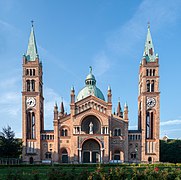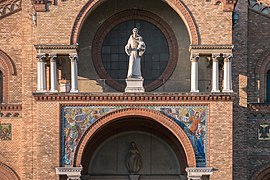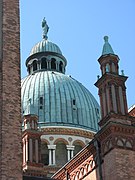Antonsplatz (Vienna)
| Antonsplatz | |
|---|---|
| Place in Vienna | |

|
|
| Basic data | |
| place | Vienna |
| District | Favoriten (10th district) |
| Created | 1897 |
| Confluent streets | Schröttergasse, Gellertgasse, Inzersdorfer Straße, Wirerstraße, Neusetzgasse |
| Buildings | Anton Church |
| use | |
| User groups | Pedestrians , bicycle traffic , car traffic , bus route 7A |
| Space design | one way street |
| Technical specifications | |
| Square area | 27053 m² |
The Antonplatz located in the 10th Vienna district favorites . It was in 1897 after the Saints Anthony of Padua named the Anton church consecrated in the middle of the square.
history
A brick factory was originally located south of today's Antonsplatz. In 1834, the coffee maker Leander Prasch converted it into an entertainment venue. Since the later 10th district was still undeveloped at that time, one had a great panoramic view of Vienna from the old estate . It was one of the best-known entertainment venues of the Biedermeier period, where musicians such as Josef Lanner , Friedrich Fahrbach and Franz Morelly played to dance. After the establishment's decline, the spacious garden was converted into a field in 1851, and the building became a factory that existed until 1871. Even today, the Landgutgasse and the Alte Landgut in the Favoriten district are reminiscent of the former entertainment venue.
Location and characteristics
Antonsplatz is a large trapezoidal square south of Reumannplatz in the center of Favoriten. It extends between Schröttergasse in the north and Inzersdorfer Straße in the south. In the middle it is crossed in an east-west direction by Gellertgasse, while from Antonsplatz the Neusetzgasse goes to the north and the Wirerstraße to the south, the eastern side of the square extends in the Rechberggasse to the south. The vast majority of the area of the Antonsplatz is taken up by a green area, in the center of which the monumental building of the Antonskirche rises. The lanes along the sides of the square are run as one-way lanes. Some of the former tram tracks of lines 67 and 167 from the years 1971-78 can still be seen here, today the bus line 7A runs via Antonsplatz, which also has a stop here.
The original plan was to create a representative center for the new and rapidly growing 10th district with the construction of the Antonskirche and Antonsplatz. In fact, this function has taken over the nearby Reumannplatz, which has become a heavily frequented traffic junction, while the Antonsplatz makes a calm and quiet impression away from the traffic, which, apart from the residents, is only visited by pensioners, dog owners and children and young people playing because of the green area. Most of the houses on Antonsplatz still consist of an association of four to five-story apartment buildings from the end of the 19th century and the beginning of the 20th century.
The Antonsplatz today also has a certain oriental charm, as the Antons Church itself was built in a Romanesque-Byzantine style with a large dome, which is adjacent to the rectory in the Venetian style and a large Armenian cross. In addition, the square is currently home to three Turkish-Islamic cultural associations with a prayer room and a youth center.
building
Parish Church of St. Anthony of Padua
The largest and most magnificent church in Favoriten is dominantly located in the middle of Antonsplatz and can be seen from afar through the streets leading to the square. Especially from Reumannplatz, through the short Neusetzgasse, the front of the church with the main portal, the dome and the large figure of Christ crowning it can be seen clearly. Erected between 1896 and 1901 according to plans by Franz von Neumann , the models Sant'Antonio in Padua and San Marco in Venice are clearly recognizable. The church was badly destroyed by bombs on November 6, 1944 and December 11, 1944 during World War II, so that the construction and renovation work could not be completed until 1961. Due to a lack of money, however, the interior fittings, especially the wall paintings by August Wörndle, could not be restored. As a result, the impression of the interior today is completely different from that of the original state. Walls and ceilings are largely empty with the exception of the apse, the items of furniture come from the post-war period.
The largest and most important relic of this saint in Vienna is located on the Antonius Altar in the Anton Church, a 6 cm piece of rib. The oldest works of art in the church are originally from elsewhere. It is a Pieta from around 1700 and a Saint John Nepomuk from the 18th century, both of which were in the Schmelzer cemetery .
Christ Pantocrator by Ernst Bauernfeind
Rectory
The rectory, which was also built around 1900, is located in the green area of the square, free-standing next to the church. It is provided in the middle with a trifore built in the Venetian-Gothic style and shows the mural of a Madonna. There are exposed bricks on the upper floor of the cubic building.
Armenian cross
To thank you for the help that came from Austria after the great earthquake disaster in Armenia in 1988, a block with a cross in relief in traditional Armenian shapes was set up between Anton's Church and the rectory.
literature
- Herbert Tschulk: Viennese district culture guide favorites . Jugend & Volk, Vienna 1985, ISBN 3-224-16255-4
- Dehio Handbook Vienna. X. to XIX. and XXI. to XXIII. District . Anton Schroll, Vienna 1996
Web links
Coordinates: 48 ° 10 ′ 16.6 ″ N , 16 ° 22 ′ 37.1 ″ E











